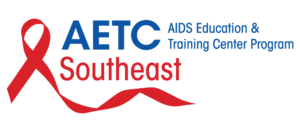
Think You Know How To Prophylax Against MAC? THINK AGAIN.
By:
- Jeanette Alava, PharmD Candidate
College of Pharmacy, Nova Southeastern University - Maia Goldenberg, PharmD Candidate
College of Pharmacy, Nova Southeastern University - Elizabeth Sherman, PharmD, AAHIVP
College of Pharmacy, Nova Southeastern University
South Florida, Southeast AETC
Disseminated Mycobacterium avium complex (MAC) disease is one of many opportunistic infections that are the hallmark of acquired immunodeficiency syndrome (AIDS). Up until 2019, previous opportunistic infection guidelines set forth by the Centers for Disease Control and Prevention, the National Institutes of Health, and the HIV Medicine Association of the Infectious Diseases Society of America recommended that all patients with HIV and a CD4 count < 50 cells/mm3 should receive MAC primary prophylaxis. However, recent data have shown primary prophylaxis for MAC is not required in patients with HIV who immediately start ART or those with an undetectable HIV RNA while receiving ART. Here, we review the top 3 updates you need to know in order to keep your clinical practice in line with updated guideline recommendations.
- 1. Primary prophylaxis against disseminated MAC disease is not recommended for adults and adolescents with HIV who immediately initiate ART, regardless of CD4 count.1 This change is in sharp contrast to previous guideline editions where MAC primary prophylaxis was given routinely to patients living with HIV with CD4 < 50 cells/mm3. Primary MAC prophylaxis, if previously initiated, should be discontinued in those on a fully suppressive ART regimen.
- 2. The updates were driven by recent studies showing no added benefit to continuing MAC prophylaxis. Here’s what you need to know about these studies:
- a. In a retrospective study of 369 patients with HIV, a CD4 < 50 cells/mm3, no previous MAC diagnosis, and on combination ART, 7/194 patients without prophylaxis and 4/175 patients with prophylaxis developed a MAC infection (p = 0.64) within the 6 month study period. 71 patients who were virologically suppressed (< 1,000 copies/mL) with a CD4 < 50 cells/mm3, did not develop a MAC infection, regardless of MAC prophylaxis.4
- b. In a retrospective study of 157 patients, the incidence of MAC disease between the prophylaxis and non-prophylaxis group was not statistically significant (3.4 vs 0.8 per 100 patient-years, p = 0.368). These patients had a CD4 < 50 cells/mm3 and were on triple antiretroviral drug therapy (including either one PI, NNRTI, or INSTI).3
- 3. Although primary prophylaxis for MAC will not be as common as in previous years, it should not be discontinued or disregarded in all patients. There are a few clinical scenarios that justify its use. Here’s who should still get MAC primary prophylaxis (See Figure 1).
- a. Key criteria for patients who require MAC primary prophylaxis include the absence of fully suppressive ART in combination with a CD4 < 50 cells/mm3.1 Patients who fall under this category are currently not on ART or are still viremic despite being on ART.
- b. There are many reasons why patients are currently not on ART. Patients must be able to commit to therapy and understand the importance of adherence. They may not have access to appropriate health care resources, housing, or support to maintain adherence. Patients who delay ART therapy or are not able to be adherent should receive MAC primary prophylaxis.
- c. MAC primary prophylaxis includes the regimens reviewed in Table 1 below and may be discontinued when patients are started on a fully suppressive ART regimen.1
In summary, MAC primary prophylaxis is not indicated for everyone and should only be initiated in certain patient populations. Practitioners should assess their patients to see if they fit the criteria to initiate, continue, or discontinue MAC primary prophylaxis based on the information provided above. More detailed information can be found in the updated Guidelines for Prevention and Treatment of Opportunistic Infections in HIV-Infected Adults and Adolescents.1
Table 1: MAC Primary Prophylaxis Regimen |
|
| Preferred Therapy | Alternative Therapy |
|
|
Figure 1: MAC Primary Prophylaxis in Adults and Adolescents
References:
- Panel on Opportunistic Infections in HIV-Infected Adults and Adolescents. Guidelines for the prevention and treatment of opportunistic infections in HIV-infected adults and adolescents: recommendations from the Centers for Disease Control and Prevention, the National Institutes of Health, and the HIV Medicine Association of the Infectious Diseases Society of America. Available at http://aidsinfo.nih.gov/contentfiles/lvguidelines/adult_oi.pdf. Accessed (February 15, 2019) [A-1, G-1 – G-6]
- Currier MD. Mycobacterium avium complex (MAC) infections in HIV-infected patients. Post TW, ed. UpToDate. Waltham, MA: UpToDate Inc. (Accessed on February 27, 2018.)
- Jung Y, et al. (2017). Incidence of disseminated Mycobacterium avium-complex infection
in HIV patients receiving antiretroviral therapy with use of Mycobacterium aviumcomplex prophylaxis. International Journal of STD & AIDS, 28(14), 1426-1432. doi:10.1177/0956462417713432 - Yangco BG, et al. (2014). Is primary Mycobacterium avium complex prophylaxis necessary in patients with CD4 <50 cells/μL who are virologically suppressed on cART? AIDS Patient Care and STDs, 28(6), 280-283. doi:10.1089/apc.2013.0270

